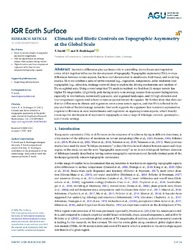Climatic and Biotic Controls on Topographic Asymmetry at the Global Scale
Smith, T.; Bookhagen, B., 2021: Climatic and Biotic Controls on Topographic Asymmetry at the Global Scale. In: Journal of Geophysical Research: Earth Surface, Band 126, 1, DOI: 10.23689/fidgeo-4006.
 |
Dokument öffnen: |
Insolation differences play a primary role in controlling microclimate and vegetation cover, which together influence the development of topography. Topographic asymmetry (TA), or slope differences between terrain aspects, has been well documented in small‐scale, field‐based, and modeling studies. Here we combine a suite of environmental (e.g., vegetation, temperature, solar insolation) and topographic (e.g., elevation, drainage network) data to explore the driving mechanisms and markers of TA on a global scale. Using a novel empirical TA analysis method, we find that (1) steeper terrain has higher TA magnitudes, (2) globally, pole‐facing terrain is on average steeper than equator‐facing terrain, especially in mid‐latitude, tectonically quiescent, and vegetated landscapes, and (3) high‐elevation and low‐temperature regions tend to have terrain steepened toward the equator. We further show that there are distinct differences in climate and vegetation cover across terrain aspects, and that TA is reflected in the size and form of fluvial drainage networks. Our work supports the argument that insolation asymmetries engender differences in local microclimates and vegetation on opposing terrain aspects, which broadly encourage the development of asymmetric topography across a range of lithologic, tectonic, geomorphic, and climatic settings. Key Points:
Steep terrain has higher topographic asymmetry magnitudes.
Pole‐facing terrain is on average steeper than equator‐facing terrain.
High‐elevation and low‐temperature regions tend to have terrain steepened towards the equator.
Statistik:
ZugriffsstatistikSammlung:
- Geologie [933]
Schlagworte:
erosionfreeze‐thaw cycling
solar radiation
topographic asymmetry
topography
vegetation cover
This is an open access article under the terms of the Creative Commons Attribution‐NonCommercial License, which permits use, distribution and reproduction in any medium, provided the original work is properly cited and is not used for commercial purposes.

